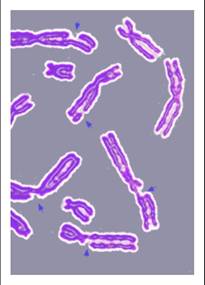Contents
Introduction
Sources
of damage
Types
of repair mechanisms
DNA
repair and aging
DNA
repair and cancer
References
Introduction
DNA repair refers to a collection of
processes by which a cell identifies and corrects damage to the DNA molecules
that encode its genome.
Sources of
damage
Endogenous
damage:
Spontaneous
mutation
Oxidative
deamination
Exogenous
damage:
Ultraviolet [UV
200-300nm] radiation
X-rays and Gamma
rays
Plant toxins
Mutagenic
chemicals
Chemotherapy and
Radiotherapy
Types of repair
Preventative
Direct DNA
repair
Post replication
repair
Preventative
repair
Eliminate
superoxide free radicals
Direct DNA
repair
Mainly three
types:
Alkyltransferase
Photoreactivation
Excision repair
Alkyltransferases
A group of
enzymes which remove alkyl group from the bases of DNA
The best studied
of the alkyltransferase is O6 – methyl guanine methyl transferase (MGMT).
Photoreactivation
Restores
dimerized pyrimidines to their original form
Excision Repair
Recognizes and
excises damaged nucleotides and arrange them with the correct ones
Postreplication
repair
There are mainly
three types:
Recombination
repair
Mismatch repair
SOS response
Recombination
repair
Replaces a
lesions with the addition of correct nucleotides using one strand as a template
Mismatch repair
system
Replaces
mismatched nucleotides with the correct one
SOS responses
Activate
excision, recombination and other response mechanisms
DNA repair and
aging
DNA repair and
cancer
Inherited
mutations that affect DNA repair genes are strongly associated with high cancer
risks in humans.
Hereditary
nonpolyposis colorectal cancer (HNPCC) is strongly associated with specific
mutations in the DNA mismatch repair pathway.
BRCA1 and BRCA2,
two famous mutations conferring a hugely increased risk of breast cancer on carriers,
are both associated with a large number of DNA repair pathways.
DNA bases may be modified by deamination OR alkylation.
The position of the modified (damaged) base is called the ‘abasic site’ or ‘AP site’
In the E.coli the DNA glycolsylase can recognize the AP site and remove its bases.
Then the AP endonuclease removes the AP site and neighbouring nucleotides.
The Gap is filled by DNA polymerase I and DNA ligase.
NUCLEOTIDE EXCISION REPAIR
In E.coli proteins UvrA, UvrB, UvrC are involved in removing the damaged nucleotides.
The gap is then filled by DNA polymerase I and DNA ligase.
Nucleotide excision repair is particularly important in recongnising thymine dimers that form as a result of exposure to UV radiation.
MISMATCH REPAIR
To repair mismatched bases the system has to know which base is the correct one.
In E.coli this is achieved by a special methylase called “Dam methylase”, which can methylate all adenines that occur within (5’) GATC sequence.
To distinguish old and new strand old strand is methylated while new is not.
CONCLUSION
DNA repair mechanisms promote genomic stability and prevent cancer.
Thus, DNA repair mechanisms provide a way of proofreading and repairing damaged DNA.
DNA bases may be modified by deamination OR alkylation.
The position of the modified (damaged) base is called the ‘abasic site’ or ‘AP site’
In the E.coli the DNA glycolsylase can recognize the AP site and remove its bases.
Then the AP endonuclease removes the AP site and neighbouring nucleotides.
The Gap is filled by DNA polymerase I and DNA ligase.
NUCLEOTIDE EXCISION REPAIR
In E.coli proteins UvrA, UvrB, UvrC are involved in removing the damaged nucleotides.
The gap is then filled by DNA polymerase I and DNA ligase.
Nucleotide excision repair is particularly important in recongnising thymine dimers that form as a result of exposure to UV radiation.
MISMATCH REPAIR
To repair mismatched bases the system has to know which base is the correct one.
In E.coli this is achieved by a special methylase called “Dam methylase”, which can methylate all adenines that occur within (5’) GATC sequence.
To distinguish old and new strand old strand is methylated while new is not.
CONCLUSION
DNA repair mechanisms promote genomic stability and prevent cancer.
Thus, DNA repair mechanisms provide a way of proofreading and repairing damaged DNA.
References
Lodish H, Berk
A, Matsudaira P, Kaiser CA, Krieger M, Scott MP, Zipursky SL, Darnell J.
(2004). Molecular Biology of the Cell, p963. WH Freeman: New York, NY. 5th ed.
Toshihiro Ohta,
Shin-ichi Tokishita, Kayo Mochizuki, Jun Kawase
Masahide
Sakahira and Hideo Yamagata, UV Sensitivity and Mutagenesis of the Extremely
Thermophilic Eubacterium Thermus thermophilus HB27, Genes and Environment Vol.
28 (2006) , No. 2 p.56-61.
Watson JD, Baker
TA, Bell SP, Gann A, Levine M, Losick R. (2004). Molecular Biology of the Gene,
ch. 9 and 10. Peason Benjamin Cummings; CSHL Press. 5th ed.














No comments:
Post a Comment